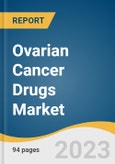The global ovarian cancer drugs market size is expected to reach USD 5.65 billion by 2030, registering a CAGR of 6.6% from 2023 to 2030. The growth of the market is largely driven by factors such as increased adoption of novel drugs and presence of strong pipeline. Rising incidence of ovarian cancer due to growing geriatric population and unhealthy lifestyles is providing an upthrust to the market.
Ovarian cancer accounts for 3.0% of all malignant tumors among women and 6.0% of all femaledeaths due to cancer. Ovarian cancer accounted for 235, 200 new cases and 140, 000 deaths worldwide in 2016 with the highest incidence being reported in North America and Europe.
Introduction of non-platinum based PARP inhibitors and VEGF inhibitors in second and third-line settings has changed the treatment regime for ovarian cancer dramatically. Several biologic and small-molecule therapies including antibody drug conjugates (ADC) in development are estimated to have a major impact on ovarian cancer treatment spectrum.
Ovarian cancer accounts for 3.0% of all malignant tumors among women and 6.0% of all femaledeaths due to cancer. Ovarian cancer accounted for 235, 200 new cases and 140, 000 deaths worldwide in 2016 with the highest incidence being reported in North America and Europe.
Introduction of non-platinum based PARP inhibitors and VEGF inhibitors in second and third-line settings has changed the treatment regime for ovarian cancer dramatically. Several biologic and small-molecule therapies including antibody drug conjugates (ADC) in development are estimated to have a major impact on ovarian cancer treatment spectrum.
Ovarian Cancer Drugs Market Report Highlights
- Based on treatment, the hospital pharmacy segment held the largest revenue share of 45.37% in 2022. An increasing number of government initiatives and funding for cancer research and treatment are driving drug development and accessibility, ensuring that effective ovarian cancer drugs are available in hospital settings. Based on application, the commercial segment dominated with the largest revenue share of 88.0% in 2022. This is due to the rising demand for generic drugs, and the high burden of chronic diseases are some factors contributing to the growth
- For instance, in 2020, according to the Commonwealth of Australia, the Australian Government allocated USD 16.2 million toward eight research projects dedicated to addressing ovarian cancer. In Australia or globally, ovarian cancer has consistently maintained the lowest survival rate among all female cancers. On average, 43 out of every 100 women diagnosed with ovarian cancer survived five years after their diagnosis.
- The online pharmacy segment is expected to grow at the fastest CAGR of 8.1% over the forecast period. The convenience of online pharmacies in facilitating the ordering and delivery of ovarian cancer drugs directly to patients' homes, particularly those with health limitations, is a significant driver of the online pharmacy segment in the ovarian cancer drugs treatment market. This accessibility eliminates barriers to obtaining essential medications, enhancing patient adherence to treatment regimens and expanding the market reach for these drugs.
- For instance, AdooQ BioScience provides a convenient platform for customers to order ovarian cancer drugs, specifically Rucaparib. On the webpage, customers can access detailed information about the drug, including its name, description, dosage forms, and pricing.
- North America dominated the industry with a market share of 43.47% in 2022 due to various factors, such as the high incidence of ovarian cancer in North America is a key driver of the region's ovarian cancer drugs market as it results in a significant and ongoing demand for effective treatments, fostering pharmaceutical research, and innovation to cater to the needs of the substantial patient population.
- For instance, according to the American Cancer Society's 2023 estimates for ovarian cancer in the United States, approximately 19, 710 women are expected to be newly diagnosed, while approximately 13, 270 women are projected to lose their lives to ovarian cancer. ·
- Asia Pacific is expected to witness the fastest CAGR of 8.0% over the forecast period due to the increased participation in clinical trials in the region not only provides ovarian cancer patients with access to cutting-edge treatments but also fosters drug development by attracting pharmaceutical companies and researchers, thereby advancing the ovarian cancer drugs market in the region. ·
- For instance, according to the Clinical Trials Arena, from 2017 to 2022, Asia Pacific experienced an impressive increase of approximately 10% in clinical trials, surpassing the growth rate observed in other major regions like the U.S. and Europe. This growth in the region significantly outpaced the overall average of 5.3% per year during the same period.
Table of Contents
Chapter 1. Methodology and Scope
Chapter 2. Executive Summary
Chapter 3. Ovarian Cancer Drugs Market Variables, Trends & Scope
Chapter 4. Ovarian Cancer Drugs: Therapeutic Class Estimates & Trend Analysis
Chapter 5. Ovarian Cancer Drugs: End-use Estimates & Trend Analysis
Chapter 6. Ovarian Cancer Drugs: Treatment Estimates & Trend Analysis
Chapter 7. Ovarian Cancer Drugs Market: Regional Estimates & Trend Analysis
Chapter 8. Competitive Landscape
List of Tables
List of Figures
Companies Mentioned
- AbbVie Inc.
- Pfizer, Inc.,
- AstraZeneca,
- F. Hoffmann-La Roche AG,
- Johnson & Johnson Services, Inc.,
- Boehringer Ingelheim International GmbH,
- Clovis Oncology,
- ImmunoGen, Inc.
- Vivesto AB
Methodology

LOADING...
Table Information
| Report Attribute | Details |
|---|---|
| No. of Pages | 94 |
| Published | September 2023 |
| Forecast Period | 2022 - 2030 |
| Estimated Market Value ( USD | $ 3.37 Billion |
| Forecasted Market Value ( USD | $ 5.65 Billion |
| Compound Annual Growth Rate | 6.6% |
| Regions Covered | Global |
| No. of Companies Mentioned | 9 |









